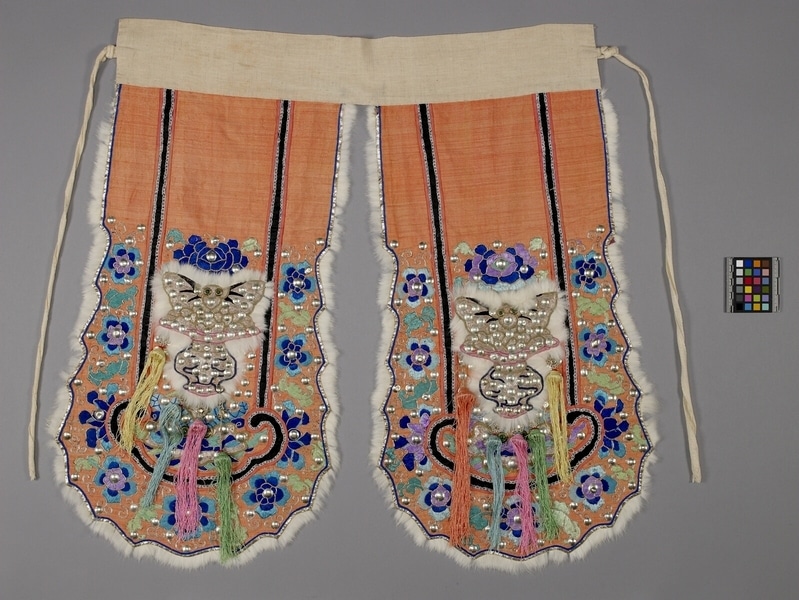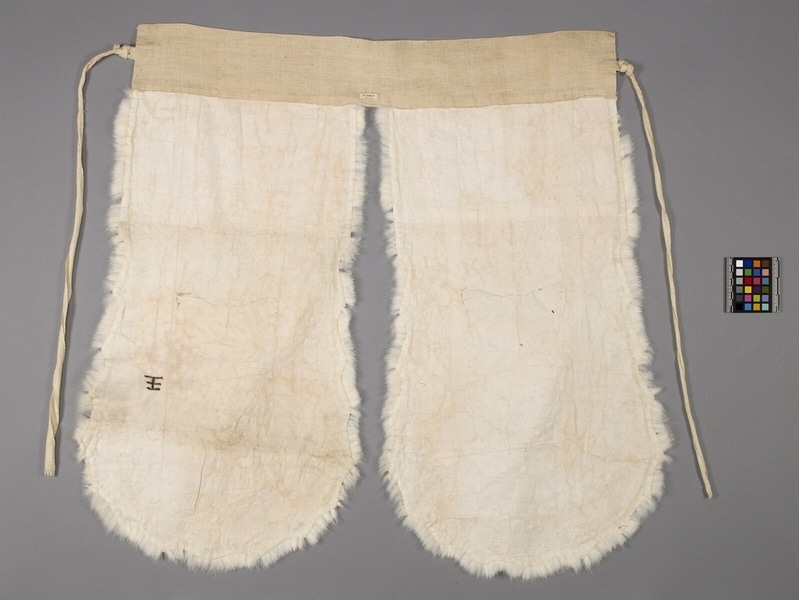Cantonese Opera Panel Item Number: N1.682 b from the MOA: University of British Columbia



Description
Orange leg panels attached across the top by a wide linen band with two ties. On the front are Fu dog, butterfly and peony motifs in gold, pink, purple, green and blue on an orange ground. Beneath the butterfly motif are yellow, green, pink, turquoise and orange tassels. There are green glass eyes, tin reflectors and white fur on the panels. The backside lining is white cotton.
History Of Use
These panels were worn at the hips, underneath armour made in typical Cantonese style, narrower than that used in northern opera. It is called “great armour”, “daaih kau”. It was worn to represent a general of military role type, “mouh saang”. It could have been used for one of the generals in the auspicious act “Six Kingdoms Present a Chancellor”, “Luhk Gwok Daaih Fung Seuhng”. Each general would have worn a different colour. This set may have been worn to represent the general Jyu Wahn, of one of the Three Kingdoms. It was worn with a full-length costume with front and back panels, with a collar, and probably with a set of four flags at the back. The style of most Cantonese opera costumes derives from clothing of the Ming Dynasty, with the exception of some costumes that are specific in style to clothing of the Qing Dynasty, for operas set in that dynasty. Ming Dynasty style costumes are used for operas set in all other dynasties. In Cantonese opera, the standards for indicating particular role types and character types through costumes were and are not as strict as those for Beijing opera, and the use of symbols appears to have been inconsistent. The performance style of Cantonese opera is also much more flexible than that of Beijing opera, and change and novelty were and are valued. This is reflected in the costumes. It was important that robes and headdresses be appropriate to each other, but the footwear was less strictly controlled. Early in the twentieth century there was a multiplicity of role types, but the number of role types was simplified over time, and some were merged. More than one actor can play a particular role type at any one time, and they are ranked. A basic list follows, but more role types exist. Among the female role types are those who can fight (called “fa daan”). The highest of these can sing, and is called the ”jing yahn fa daan”. Another female role type is the “ching yi”, a humble, struggling gentlewoman. A third female role type is the old woman “louh daan”. A fourth is the female clown “neuih chauh”. Male role types include the “siu saang” (young gentleman), “mouh saang” (military man), “fa mihn” (painted face, military man with less education), “sou saang” (bearded gentleman, older civil male), “jung saang” (mid-rank male with many skills, but not outstanding), and “chauh saang” (male clown). Costumes are specific to general role type and often to character type, but rarely to the specific character. They are divided into civil and military types, as indicated by their sleeves. Civil costumes have wide sleeves, while military costumes have tight sleeves. Other details such as colour indicate the role type and character type. As indicated by this collection, “water sleeves” “seuih jauh” were rarely used in the pre-World War II period. Many costumes conform to named types, such as “yuhn lehng” “round neck” and “hoi ching”, scholar’s long robe overlapping at the front, with wide sleeves.
Male and female role types can be played by either men or women, depending on their abilities and attributes. In the past, troupes were all-male, but later all-female troupes and mixed troupes were formed. Mixed troupes were accepted in the overseas Chinese context before they were accepted in China.
Iconographic Meaning
The narrow sleeves indicate that this costume is for a military role rather than a civil role.
Cultural Context
theatre
Specific Techniques
All seams are enclosed. All stitching that can be seen is hand-sewn. Cotton lining is pasted to outer layer. Wear on other costumes made of similar fabric suggests that it is silk warp with cotton weft, or vice-versa.
Narrative
A large group of Cantonese opera costumes, musical instruments, props, trunks, and stage fittings was left with the Jin Wah Sing Musical Association, apparently by some of the many itinerant troupes visiting Vancouver to perform in the Chinatown theatres in the pre-World War II period. There is no certain knowledge of why these materials were not taken back to China by them. They were used by the Jin Wah Sing Musical Association in their performances until they became too dated. The association continued to preserve them carefully, storing them in their headquarters and in the basement of the Chinese Freemasons building until several groups of materials were sold and donated to the Museum of Anthropology.
Item History
- Made in Guangzhou, Guangdong, China ? during 1925
- Collected in Vancouver, British Columbia, Canada
- Owned by Jin Wah Sing Musical Association before August 28, 1973
- Received from Barrett Montford Endowment Fund (Funding source), Jin Wah Sing Musical Association (Seller), Leon & Thea Koerner Foundation (Funding source), Museum of Anthropology Donations Fund (Funding source), Mah Society of North America (Funding source), Canada-China Friendship Association (Funding source), Quon H. Wong Agencies (Funding source) and Edith Low-Beer (Funding source) on August 28, 1973
What
- Name
- Cantonese Opera Panel
- Identification Number
- N1.682 b
- Type of Item
- panel
- Material
- silk fibre, cotton fibre, rabbit skin, glass, brass metal, paste adhesive, paper, silver metal, gold metal and dye
- Manufacturing Technique
- woven, dyed, sewn, embroidered, padded, appliqued, stiffened, glued and couched
- Overall
- height 80.0 cm, width 81.5 cm
Who
- Culture
- Chinese: Cantonese
- Previous Owner
- Jin Wah Sing Musical Association
- Received from
- Barrett Montford Endowment Fund (Funding source), Jin Wah Sing Musical Association (Seller), Leon & Thea Koerner Foundation (Funding source), Museum of Anthropology Donations Fund (Funding source), Mah Society of North America (Funding source), Canada-China Friendship Association (Funding source), Quon H. Wong Agencies (Funding source) and Edith Low-Beer (Funding source)
Where
- Holding Institution
- MOA: University of British Columbia
- Made in
- Guangzhou, Guangdong, China ?
- Collected in
- Vancouver, British Columbia, Canada
When
- Creation Date
- during 1925
- Ownership Date
- before August 28, 1973
- Acquisition Date
- on August 28, 1973
Other
- Item Classes
- textiles
- Condition
- good
- Accession Number
- 0248/0067 b